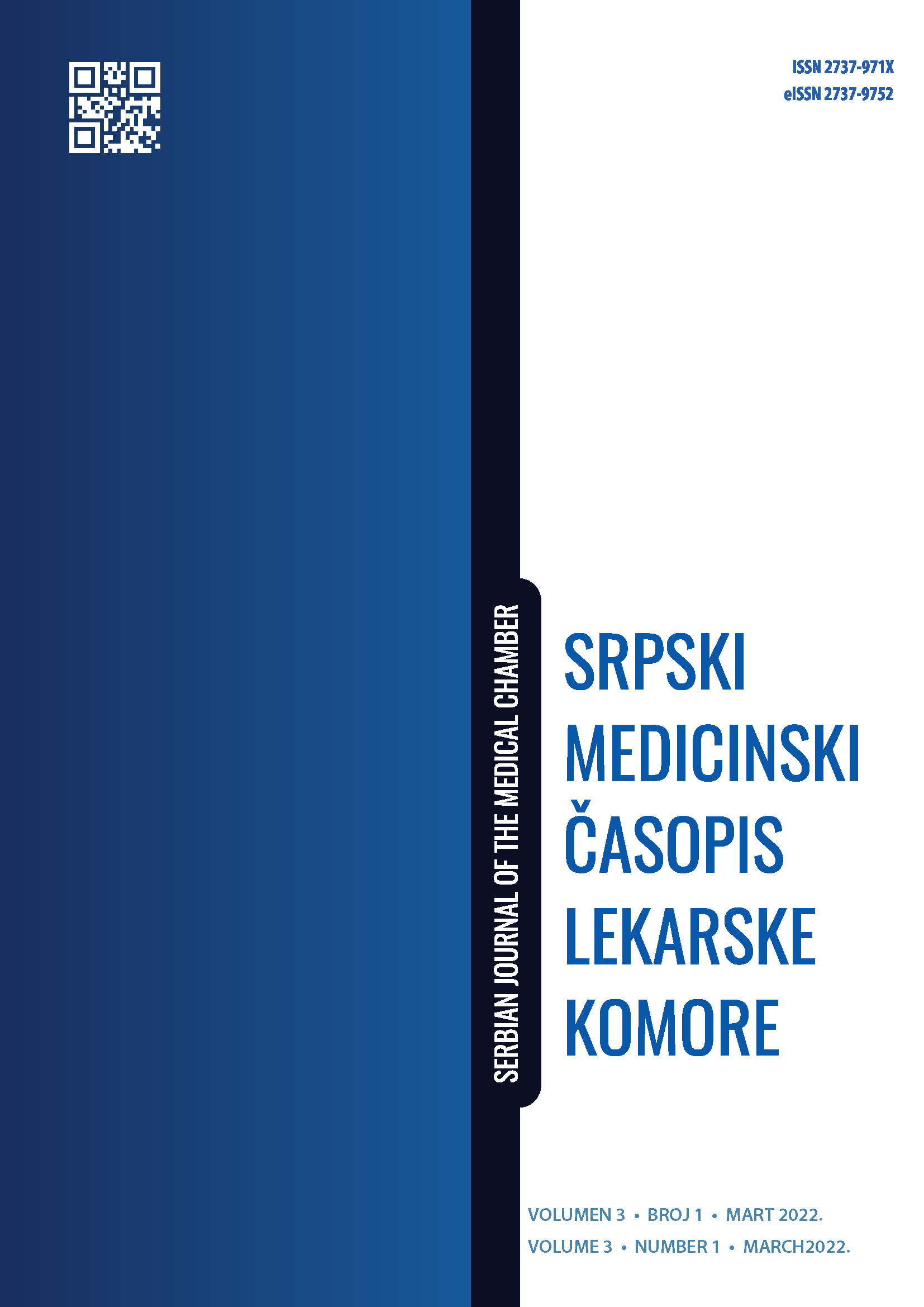BACTERIAL INFECTIONS IN PATIENTS IN ALLOGENIC STEM CELL TRANSPLANTATION PROGRAMS
Abstract
Introduction: Bacterial infections are common in patients enrolled in allogenic hematopoietic stem cell transplantation. Infections are the most common cause of illness and mortality in transplanted patients. The most common pathogens are Staphylococcus and Enterobacteriaceae, causing 25% of bacterial infections, each, followed by Enterococcus and P. aeruginosa.
Aim: The aim of the paper is calculating the frequency of bacterial infections in patients enrolled in allogenic hematopoietic stem cell transplantation, at the Clinic for Hematology of the University Clinical Center of Serbia, as well as analyzing the epidemiological situation, the frequency of different clinical presentations of bacterial infections, and their effect on overall survival.
Materials and methods: This retrospective cohort study enrolled 58 patients. The presence of bacteria was determined with standard microbial cultivation from samples. The diagnosis criteria for localized bacterial infection are a positive culture and characteristic clinical presentation. Sepsis is clinically diagnosed by a combination of a positive hemoculture and the existence of systemic inflammatory response. Management of bacterial infection starts empirically and is continued in keeping with antibiogram results. Patient survival was analyzed with the Kaplan-Meier method and compared with the log-rank test.
Results: Bacterial infections were registered in 15 (25.9%) patients. The most common pathogens were Gram-negative bacteria (65.2%). The most common clinical presentation was sepsis (59.0%). Bacterial infection lethality was 60%. The Kaplan-Meier curve showed the median value for estimated patient survival in patients without bacterial infection to be 106.0 months (95% CI 85.2 – 163.3), while, for patients with bacterial infection, it was 14.0 (95% CI 8.9 – 19.1). The log-rank test showed a significant difference in the length of survival between these two groups (p < 0.001). Pseudomonas spp. was sensitive to colistin and/or meropenem. Klebsiella pneumoniae was sensitive to colistin.
Conclusion: Bacterial infections are common at our clinic and are caused by endogenous opportunistic bacteria. Therefore, emphasis should be placed on the implementation of preventive measures aimed at preventing hospital-acquired infections.
References
- Fishman JA. Infection in solid-organ transplant recipients. N Engl J Med 2007;357(25):2601–14
- Wingard JR, Hsu J, Hiemeny JW. Hematopoietic stem cell transplantation an overview of infection risk and epidemiology. Infect Dis Clin North Am 2010;24(2):257–72.
- Tahuanty Pena, MD, MS, Julia Klesney-Tait, MD, PhD. Mycobacterial Infections in Solid Organ Hematopoietic Stem Cell Transplantation. Clin Chest Med. 2017 Dec;38(4):761-770.
- Kedia S, Acharya PS, Mohammad F, Nguyen H, Asti D, Mehta S et al. Infectious
complications of hematopoietic stem cell transplantation. J Stem Cell Res Ther
2013;S3:002 - Balletoo, M. Mikulska. Bacterial Infections in Hematopoietic Stem Cell Transplant Recipients. Mediterr J Hematol Infect Dis 2015 Jul 1;7(1):e2015045
- Helebi C, Akan H, Akc¸aglayan E, et al. Febrile neutropenia in allogeneic and
autologous peripheral blood stem cell transplantation and conventional chemotherapy for malignancies. Bone Marrow Transplant 2000;26:211 - Boucher HW, Talbot GH, Bradley JS, et al. Bad bugs, no drugs: no ESKAPE! An
update from the Infectious Diseases Society of America. Clin Infect Dis 2009; 48 (1):
1–12 - Mikulska M, Del Bono V, Viscoli C. Bacterial infections in hematopoietic stem cell
transplantation recipients. Curr Opin Hematol 2014; 21 (6): 451–458. - O Zając-Spychała1, J Wachowiak 2, A Pieczonka 2, K Siewiera 3, J Frączkiewicz 3, K Kałwak 3et all. Bacterial infections in pediatric hematopoietic stem cell transplantation recipients: incidence, epidemiology, and spectrum of pathogens: report of the Polish Pediatric Group for Hematopoietic Stem Cell Transplantation. Transpl Infect Dis. 2016 Oct; 18(5):690-698.
- Julien Coussement1, David Lebeaux, Claire Rouzaud, Olivier Lortholary. Nocardia infections in solid organ and hematopoietic stem cell transplant recipients. Curr Opin Infect Dis. 2017 Dec;30(6):545-551.
- Dan Feng1, Yong-Tian Zhang 1, Ting-Ting Qiu 2, Kai-Lin Xu 3. Clinical Features of Infection within 100 days after Hematopoietic Stem Cell Transplantation in 313 patients with Hematologic Diseases. Zhongguo Shi Yan Xue Ye Za Zhi. 2020 Apr;28(2):602-608.
- Gustinetti G, Mikulska M. Bloodstream infections in neutropenic cancer
patients: a practical update. Virulence 2016;7:280e97 - Meera Mohan1, Sandra Susanibar-Adaniya 1, Amy Buros 1, Juan Carlos Rico Crescencio 2, Mary J Burgess 3 et all. Bacteremias following autologous stem cell transplantation for multiple myeloma: Risk factors and outcomes. Transpl Infect Dis. 2019 Apr;21(2)e13052.
- Rosa RG, Dos Santos RP, Goldani LZ. Mortality related to coagulase-negative staphylococcal bacteremia in febrile neutropenia: A cohort study. Can J Infect Dis Med Microbiol
- Shaw BE, Boswell T, Byrne JL, Yates C, Russell NH. Clinical impact of MRSA in a stem cell transplant unit: analysis before, during and after an MRSA outbreak. Bone Marrow Transplant2007; 39:623-9.

